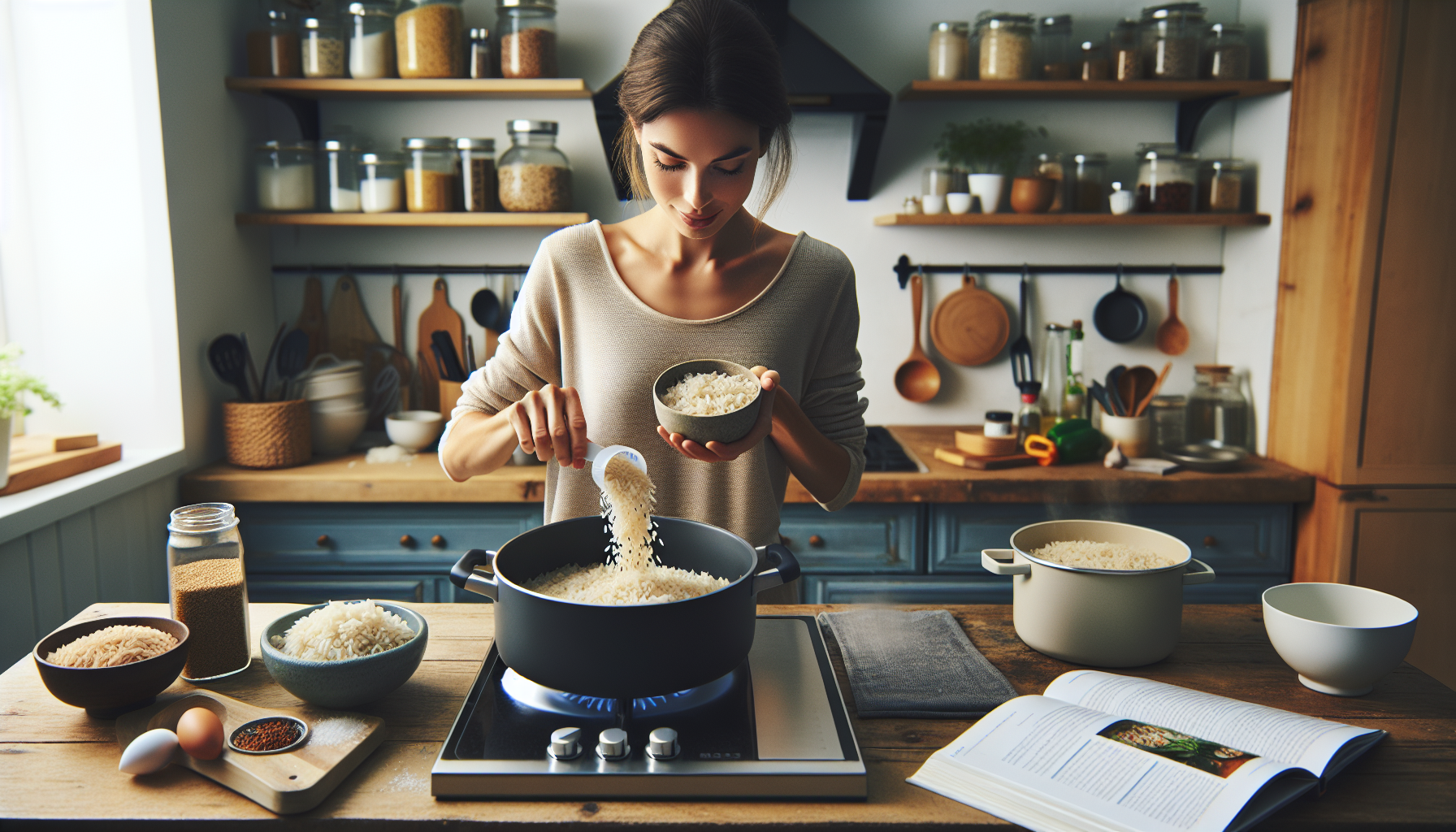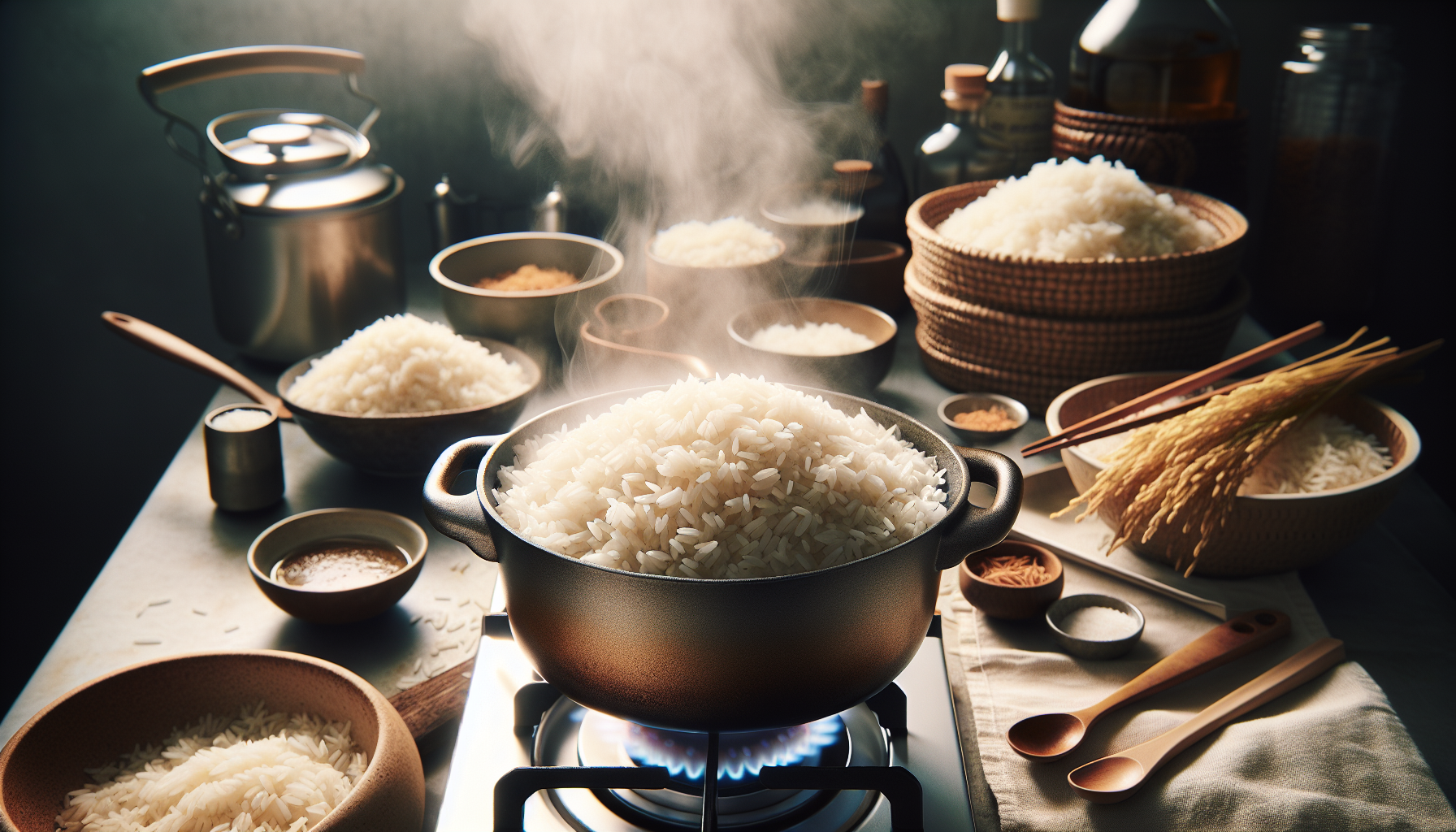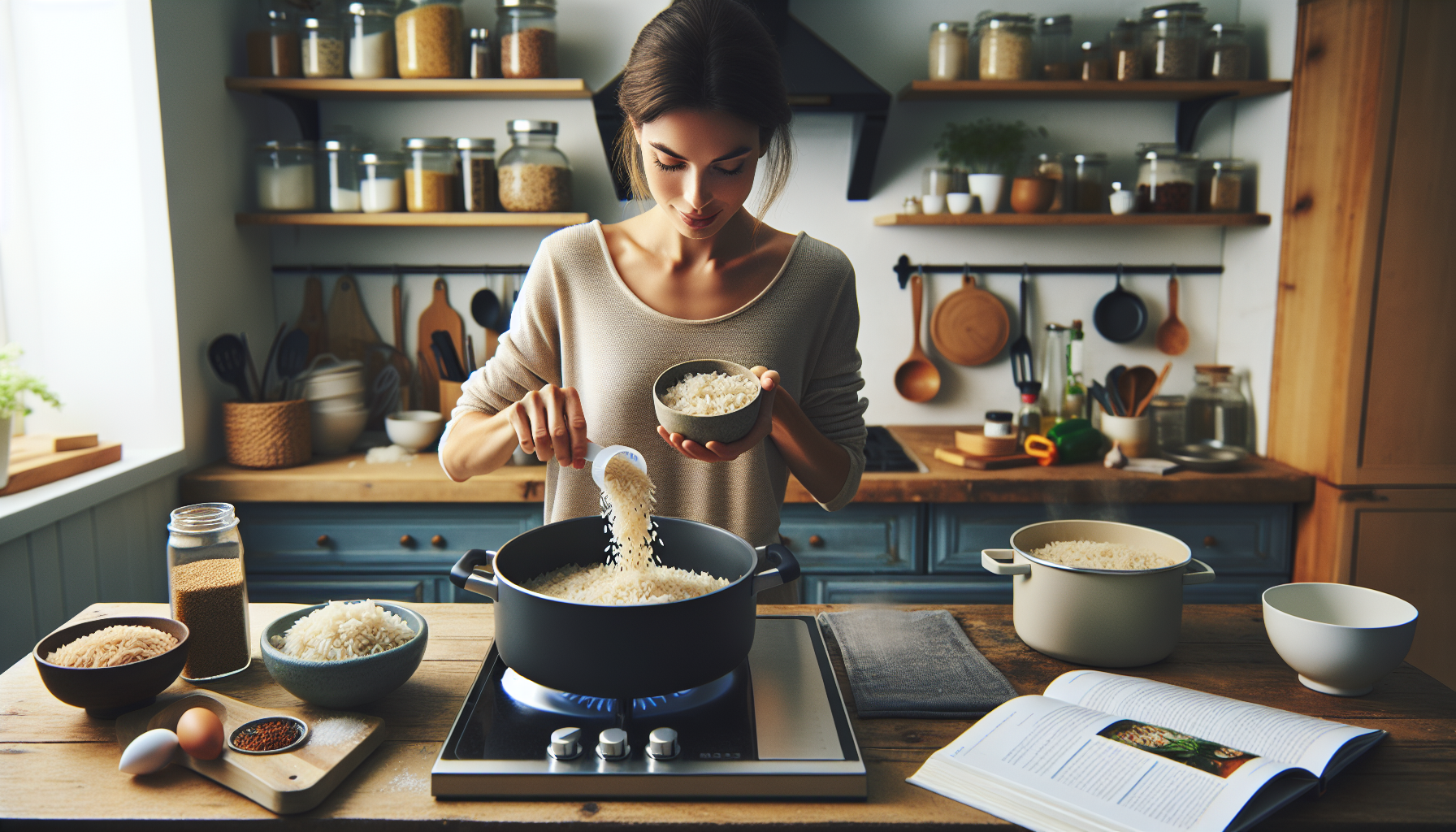If you find yourself often cooking for one, you may have encountered the challenge of making the perfect amount of rice without any leftovers. It can be a struggle to estimate the right portion size and prevent wastage. But fear not! In this article, we will explore some of the best methods to cook rice for one without any waste. Whether you prefer fluffy basmati or sticky sushi rice, we’ve got you covered with tips and tricks that will leave you with a delicious meal and zero leftovers. So, grab your apron and let’s get cooking!
Choosing the Right Type of Rice
When it comes to choosing the right type of rice for your meals, there are a few factors to consider. One of the first things to think about is the grain length. The length of the grain contributes to the texture and consistency of the cooked rice. Long-grain rice, such as jasmine or basmati, tends to be fluffy and separate easily, making it a great choice for dishes like stir-fried rice or pilaf. On the other hand, short-grain rice, like sushi rice, has a higher starch content, resulting in a stickier and chewier texture. This type of rice works well for sushi, rice pudding, or any recipe that requires a sticky consistency.
Another important decision to make is whether to opt for white or brown rice. White rice has the bran and germ removed, making it less nutritious but quicker to cook. It has a milder flavor and a lighter texture. Brown rice, on the other hand, retains the bran and germ, which gives it a nuttier taste and chewier texture. Moreover, it is rich in fiber and nutrients. It does take longer to cook, but the health benefits and the hearty flavor make it a popular choice for health-conscious individuals. Consider your preferences and the desired nutritional value when choosing between the two.
Lastly, consider trying parboiled rice. Parboiling is a process that involves partially boiling the rice in the husk before removing it. This process helps in retaining nutrients, making the rice more nutritious than regular white rice. Additionally, parboiled rice is less sticky and more separate when cooked, making it an excellent choice for dishes like fried rice or biryani.
Measuring the Right Amount
To ensure perfectly cooked rice every time, it is crucial to measure the right amount of rice and water. Using a measuring cup specifically designed for measuring rice can help you achieve accurate results. These cups often have markings indicating the ideal ratio of rice and water for specific types of rice.
The recommended ratio for most types of rice is one cup of rice to two cups of water. However, this ratio might vary slightly depending on personal preferences and the desired consistency of the cooked rice. It’s always a good idea to refer to the packaging instructions or recipe guidelines for the specific type of rice you are using.
Keep in mind that you can adjust the amount of water based on your personal preferences. If you prefer fluffier rice, decrease the amount of water slightly. On the other hand, if you prefer stickier rice, you can add a little more water. Don’t hesitate to experiment and find the perfect ratio for your taste.

Rinsing the Rice
Rinsing the rice before cooking not only removes any dirt or debris but also helps improve the texture and taste of the final dish. There are several benefits of rinsing rice. Firstly, rinsing removes the excess starch that can make the cooked rice sticky and clumpy. This is particularly important if you are cooking long-grain rice, as you want the grains to remain separate. Secondly, rinsing can help get rid of any unwanted impurities that might be present on the rice. Lastly, rinsing allows the rice to absorb water more evenly during cooking, resulting in evenly cooked rice.
To properly rinse rice, start by placing the desired amount of rice in a fine-mesh colander or sieve. Rinse the rice under cold water, using your hands to agitate the grains gently. Continue rinsing until the water runs clear, indicating that most of the excess starch has been washed away. Be careful not to rinse too vigorously, as you don’t want to break the grains or lose too much of the nutritious outer layers.
It’s important to note that rinsing may not be necessary for certain types of rice, such as parboiled rice or sushi rice. The packaging instructions or specific recipes will usually indicate whether rinsing is recommended.
Cooking Rice on Stovetop
Cooking rice on the stovetop is a traditional and reliable method that yields perfectly cooked grains. Follow these steps for stovetop rice cooking success.
The water-to-rice ratio is an essential aspect of stovetop rice cooking. For most white rice varieties, the ideal ratio is two cups of water for every one cup of rice. However, brown rice requires a slightly larger quantity of water, usually around two and a half cups of water for every one cup of rice. It’s important to note that different types of rice may have different water-to-rice ratios, so always refer to the specific instructions.
To begin, add the measured amount of rice and water to a saucepan or pot. Bring the water to a boil over medium heat, stirring occasionally to prevent the rice from sticking to the bottom of the pan. Once the water reaches a rolling boil, reduce the heat to low and cover the pot with a tightly fitting lid. Allow the rice to simmer and steam for the recommended cooking time, which is usually around 20 minutes for white rice and 40-45 minutes for brown rice. Avoid lifting the lid during the cooking process, as this can disrupt the steam and temperature inside the pot.
After the recommended cooking time, turn off the heat and let the rice rest, covered, for an additional 5-10 minutes. This allows the residual steam to finish cooking the rice and allows the grains to settle and become fluffy. Once the resting time is over, fluff the rice with a fork to separate the grains and release any excess steam.

Using a Rice Cooker
For those who prefer a more hands-off approach to cooking rice, a rice cooker can be a game-changer. Rice cookers are convenient kitchen appliances that take the guesswork out of cooking rice perfectly. Here’s how to use a rice cooker effectively.
To begin, measure the desired amount of rice using the measuring cup that usually comes with the rice cooker. The rice-to-water ratio is typically the same as for stovetop cooking, with two cups of water for every one cup of rice. However, always refer to the specific instructions for your rice cooker to ensure proper measurements.
Place the rinsed rice and water in the rice cooker, close the lid, and select the desired cooking settings. Most rice cookers offer different settings for white rice, brown rice, and even specific rice types like sushi rice or basmati rice. Select the appropriate setting and let the rice cooker do its magic.
Once the rice is cooked, most rice cookers will automatically switch to a “keep warm” mode to keep the rice at a safe temperature until you are ready to serve. It’s essential to avoid leaving the rice in the “keep warm” mode for an extended period, as this can lead to drying out or overcooking. Serve the rice promptly or transfer it to a separate container for storage.
Avoiding Rice Waste
Cooking the right portion size is crucial to avoid rice waste. It’s easy to get carried away and cook more rice than necessary, especially when using measurements that yield larger servings. To prevent wastage, consider preparing the right amount for your intended meal.
However, if you do happen to have leftover cooked rice, there are several ways to utilize it rather than letting it go to waste. Leftover rice can be refrigerated and used for various dishes throughout the week. It’s a versatile ingredient that can be added to stir-fries, soups, or even turned into delicious fried rice. Alternatively, you can freeze cooked rice in airtight containers or freezer bags for long-term storage. Simply thaw and reheat the rice when needed for quick and convenient meals.
Enhancing the Flavor
Rice is a versatile staple that can be transformed into a flavorful and satisfying dish with the addition of seasonings, spices, and other ingredients. Here are a few ways to enhance the flavor of your rice:
-
Adding seasonings and spices: Consider incorporating herbs, spices, or seasonings while cooking the rice. For example, adding a bay leaf, a pinch of turmeric, or a teaspoon of dried herbs like thyme or oregano can infuse the rice with additional flavor.
-
Using broth instead of water: Replace plain water with vegetable or chicken broth to give your rice a savory boost. The flavorful broth adds depth to the rice and complements a wide range of main dishes.
-
Incorporating vegetables and proteins: Mix cooked rice with sautéed vegetables, such as bell peppers, carrots, or peas, for a colorful and nutritious side dish. You can also add cooked proteins like shrimp, chicken, or tofu to create a complete meal. These additions not only enhance the flavor but also add texture and nutritional value to the dish.
Creating Variations with Rice Dishes
Rice is a versatile ingredient that can be used as a base for various delicious and satisfying dishes. Here are a few ideas to create exciting and flavorful rice variations:
-
Stir-fried rice: Combine cooked rice with sautéed vegetables, proteins, and seasonings in a hot skillet or wok to create a quick and tasty stir-fried rice. Customize the flavors by adding soy sauce, oyster sauce, or chili sauce for a touch of heat.
-
Rice salad: Mix cooled, cooked rice with fresh vegetables, herbs, and a tangy dressing for a refreshing rice salad. Consider adding ingredients like diced tomatoes, cucumbers, red onions, and a vinaigrette made with lemon or lime juice.
-
Rice bowls: Build a flavorful rice bowl by topping cooked rice with a variety of ingredients, such as grilled chicken, roasted vegetables, avocado slices, and a drizzle of sauce. This customizable option is perfect for creating nutritious and satisfying meals.
Tips for Perfectly Cooked Rice
While following the cooking instructions and ratios is essential, there are a few additional tips to ensure perfectly cooked rice every time:
-
Avoid lifting the lid while cooking: Opening the lid during the cooking process can release steam and disrupt the temperature inside the pot, resulting in unevenly cooked rice. Trust the cooking time and resist the temptation to peek.
-
Let the rice rest before serving: Allowing the rice to rest for a few minutes after cooking helps the grains settle and become fluffier. This resting time allows the steam to evenly distribute, resulting in a more consistent texture.
-
Fluff the rice with a fork: After the resting time, use a fork to gently fluff the rice. This action separates the grains and releases any excess steam, making the rice light and fluffy.
By following these tips, you can achieve consistently perfect rice that is fluffy, flavorful, and thoroughly cooked.
Storing and Reheating Cooked Rice
If you have leftover cooked rice or want to prepare a larger batch for future use, it’s essential to store and reheat it correctly to maintain its quality and taste.
To store cooked rice, allow it to cool completely before transferring it to an airtight container or resealable bag. Place the container in the refrigerator and use the rice within 3-4 days. It’s important to avoid leaving cooked rice at room temperature for an extended period, as this can promote bacterial growth.
When reheating cooked rice, it’s important to do so safely to prevent foodborne illnesses. The best method is to use a microwave or stovetop. If using a microwave, add a tablespoon or two of water to the rice to create steam and cover the container with a microwave-safe lid or microwave-safe plastic wrap. Heat the rice on medium power for 1-2 minutes per cup of rice, stirring halfway through to ensure even reheating.
If reheating on the stovetop, add a small amount of water or broth to a saucepan, then add the rice. Cover the pan and heat over low to medium heat, stirring occasionally, until the rice is heated through. Be careful not to overheat, as this can result in dry or mushy rice.
To avoid excessive reheating, it’s best to only reheat the amount of rice needed for a particular meal. This helps maintain the quality of the rice and prevents unnecessary waste.
In conclusion, cooking rice to perfection requires careful consideration of the type of rice, accurate measurements, proper rinsing techniques, and appropriate cooking methods. By following the tips and techniques outlined in this article, you can confidently prepare fluffy, flavorful rice every time. Whether you prefer stovetop cooking or using a rice cooker, experimenting with different seasonings and ingredients, or creating exciting rice variations, there are endless possibilities to explore. With a little practice and creativity, you can make rice the star of your meals while minimizing waste and maximizing flavor.
